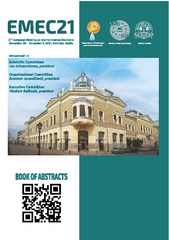Prikaz osnovnih podataka o dokumentu
The Response of Badland Materials from Spain with Different Mineralogical Content on Seasonal Changes
| dc.creator | Stefanović, M. | |
| dc.creator | Jovančićević, Branimir | |
| dc.creator | Šajnović, Aleksandra | |
| dc.creator | Gallart, F. | |
| dc.creator | Moreno-de las Heras, M. | |
| dc.creator | Antić, N. | |
| dc.creator | Kašanin-Grubin, Milica | |
| dc.date.accessioned | 2022-03-02T13:25:26Z | |
| dc.date.available | 2022-03-02T13:25:26Z | |
| dc.date.issued | 2021 | |
| dc.identifier.isbn | 978-86-7132-078-8 | |
| dc.identifier.uri | http://cherry.chem.bg.ac.rs/handle/123456789/4908 | |
| dc.description.abstract | Badlands are areas with limited vegetation, reduced or no human activity, and a great variety of geomorphic processes [1]. Badland materials have a different responsetothe same environmental conditions, because of differences in their mineralogical and physico-chemical characteristics. Many studies show that smectite-poorsediments are more resistant to different weathering treatments of freezing, thawing, wetting, and drying,than smectite-rich materials [2,3].In this paper, three unweathered samples of badlands from Spain were analyzed with the aim of monitoring, but also comparing physico-chemical changes caused by simulations of changes in climatic conditions. Selectedsediment samples havedifferent compositions. Besides quartz and calcite, the first sampleis composed of smectite and gypsum (3 UW), the second of smectite (4 UW), while the third sample is composed of neither smectite nor gypsum (5 UW). The experiment setup was designed in the way that each sample had three sub-samples, a sample for simulation of rain, snow, and a control sample (Figure 1). Sample_rain was treated with a rain intensity of ~850 ml/h for 10 minutes (~140 ml), while sample_snow was treated with crushed ice (~150 g). After precipitation simulations snow were put samples were placed in a climate chamber at - 3 °C together with a control sample. This was repeated for 15 cycles. Every cycle was documented with photographs. The leached solution was collected and its volume, pH, electrical conductivity (EC), and ion concentrations were measured. The second part of the experiment was based on exposing the samples after wetting to higher temperatures, 50 ° C. It was done in 8 cycles. FESEM and BET analyzes were performed for each sample before and after the experiments.The 3 UW samples had significantly different leachate pH and EC, while the leachate volume was similar for all samples during the experiment. Sulphate ions were leached in the highest concentrations during the whole experiment from the sample with both smectite and gypsum present. The sample with smectite has shown the highest disintegration of the structure, especially after the simulation of snow. The sample with smectite and gypsum has shown a lower degree of degradation than sample 3 UW due to the content of gypsum which increases the weathering resistance of the material. Sample 5 UW has shown the lowest degradation of the structure along with the weathering cycles. This study has proven that both mineralogical and physico-chemical properties of sediments are important for predicting their response to variable climate factors. | sr |
| dc.language.iso | en | sr |
| dc.publisher | Belgrade : Serbian Chemical Society | sr |
| dc.relation | info:eu-repo/grantAgreement/MESTD/inst-2020/200287/RS// | sr |
| dc.rights | openAccess | sr |
| dc.rights.uri | https://creativecommons.org/licenses/by/4.0/ | |
| dc.source | Book of Abstracts 21st; European Meeting on Environmental Chemistry | sr |
| dc.title | The Response of Badland Materials from Spain with Different Mineralogical Content on Seasonal Changes | sr |
| dc.type | conferenceObject | sr |
| dc.rights.license | BY | sr |
| dc.citation.spage | 52 | |
| dc.citation.epage | 52 | |
| dc.type.version | publishedVersion | sr |
| dc.identifier.fulltext | http://cherry.chem.bg.ac.rs/bitstream/id/29024/EMEC21_52.pdf | |
| dc.identifier.rcub | https://hdl.handle.net/21.15107/rcub_cherry_4908 |


